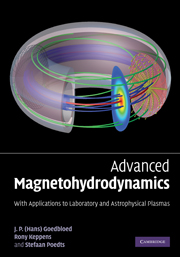17 - Linear dynamics of static toroidal plasmas
Published online by Cambridge University Press: 05 March 2013
Summary
“Ad more geometrico”
Alfvén wave dynamics in toroidal geometry
It was shown in Chapters 6–11 of Volume [1] and 12–14 of this volume that spectral theory of MHD waves and instabilities essentially concerns the dynamics of Alfvén waves in the environment of magnetized plasmas. Since Alfvén waves travel along the magnetic field lines, and the field lines in turn are constrained to the nested magnetic surfaces in an axi-symmetric toroidal plasma, this implies that the geometry of the magnetic field lines and of the constraining magnetic surfaces becomes the all-determining factor for MHD spectral theory of toroidal plasmas. Recalling the “grand vision” of Section 12.1.1 on magnetized plasmas occurring everywhere in the Universe, it is appropriate at this point to call upon the great examples of general relativity, where light waves propagate along geodesics, and upon the dream of philosophers (Spinoza) to construct the theoretical understanding of the world “ad more geometrico” (in the geometrical manner). As we will see, even when fusion applications are the main concern, it pays off to exploit the ready-made concepts of geometry expanded by the great scientists of the past.
Recall that Alfvén wave dynamics is dominated by the gradient operator parallel to the magnetic field lines, B · ∇. In toroidal geometry, this leads to such intricate dynamics that a very accurate description is needed of the geometry of the field lines and of the magnetic surfaces, i.e. of the equilibrium, if one wishes to study stability.
- Type
- Chapter
- Information
- Advanced MagnetohydrodynamicsWith Applications to Laboratory and Astrophysical Plasmas, pp. 307 - 354Publisher: Cambridge University PressPrint publication year: 2010



